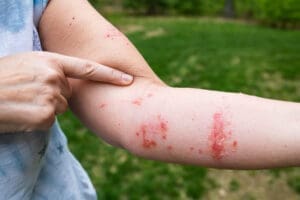Exposure to plants of the Anacardiaceae family account for the majority of cases of allergic contact dermatitis. These include poison ivy, poison oak and poison sumac, which are members of the genus Toxicodendron. These types of dermatoses are caused by urushiol, a light colorless oil present in the plant. It is highly allergic! A single exposure can cause sensitization, often with symptoms occurring in 12-18 hours after exposure.

Poison ivy plant (Toxicodendron radicans)
Doing some gardening? Here’s some useful information:
- Poison ivy causes most of the plant-related skin allergies. It is found in every state in the United States!
- The majority cases of plant dermatoses are related to direct contact with the oil. Usually damage to the plant is required for the plant to release the oil, so be careful with bruised, broken or dead plants.
- The rash related to these plants is typically very itchy; with red blisters, papules or patches often in a line or streak-like arrangement where the plant has made contact with the skin.
- Do not burn the plants! The oil from these plants is carried by smoke particles and can cause respiratory symptoms as well as severe facial dermatitis.
- “Black spot” poison ivy dermatitis occurs when the oil is left on the skin and oxidizes. This can appear as black spots that cannot be washed off. This black resin also causes skin allergy.
- Identification and avoidance of toxic plants and their allergens are key to preventing plant-related dermatoses. The oil retains its allergic potential even when dry, so dormant or dead plants should be handled with caution. The plants can still be allergic for years after they die (yes years!).
- Pets will not develop any rashes from the plants but if they touch the plant or brush up against them, the oil can be transferred to surfaces and humans.
- The oil can be acquired from contaminated surfaces, including clothing and shoes. Protective clothing can be useful, but you have to remember that all can harbor the allergic oil for many days. The oil can also seep through clothing and penetrate rubber or latex gloves (not heavy-duty vinyl or leather gloves).
- After known exposure, remove contaminated clothing and wash the whole body with mild soap on a washcloth with very warm water. This should be done as soon as possible. Clothing, tools or other items that may be contaminated with the plant oil should also be wasted with warm, soapy water.
- Since the allergic sensitization to these plants is very high, most of the treatment for plant-related skin allergies is to help relieve the symptoms:
- Soothing measures, e.g., oatmeal baths, cool soaks and wet compresses.
- Oral antihistamines may help itching.
- Topical steroids are helpful, especially when poison ivy is in its early stages.
- Oral and injectable steroids are used when dermatitis is severe.
- If there is a secondary bacterial infection, antibiotics are often used.
- It is sometimes very difficult to prevent plant-related dermatoses, however, early recognition of the culprit plants can help. Poison ivy and oak both have 3 leaves and poison sumac has 7-13 leaves often arranged in pairs.

Poison ivy allergic contact dermatitis.
When the skin comes in direct contact with an irritating or allergy-causing substance, a contact dermatitis can develop. Exposure to poison ivy, poison oak and poison sumac causes more cases of allergic contact dermatitis than all other plant families combined!
People of all ethnicities and skin types are at risk and the severity of the reaction to the plants decrease with age. If you have a rash and think you came in contact with a plant, seek professional guidance. A dermatology provider is the best source of information for questions and concerns related to dermatitis. Dr. J – JODI LOGERFO, DNP, APRN, FNP-BC
